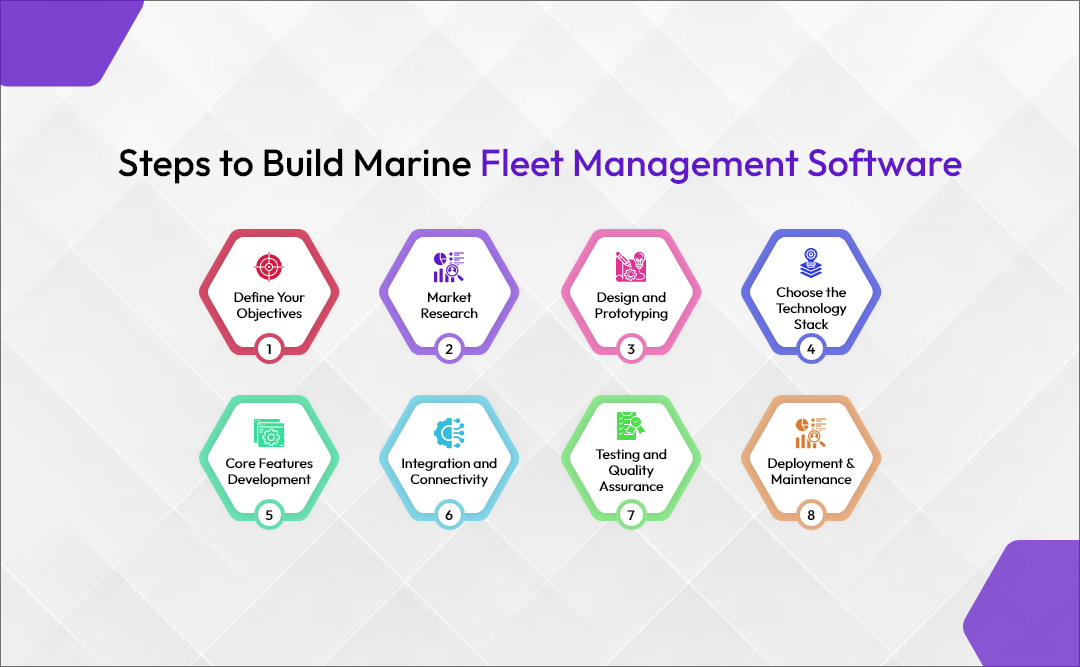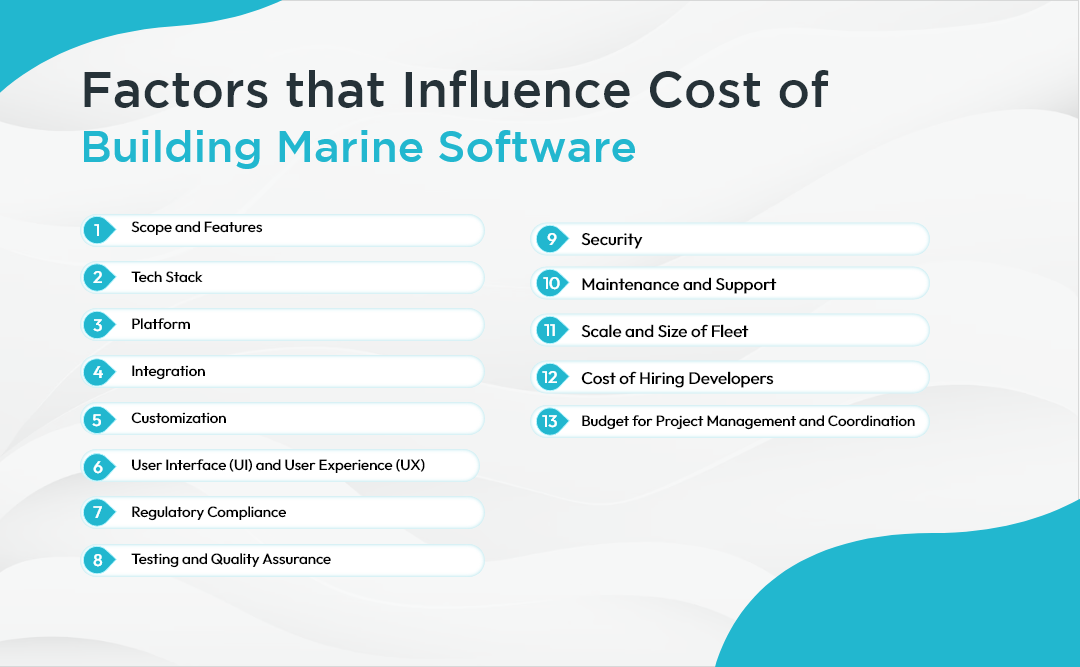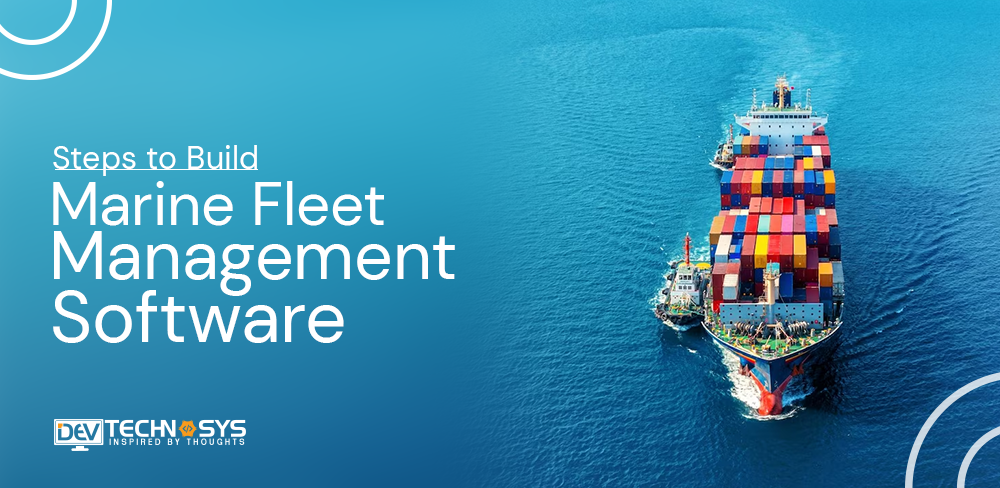The maritime industry is constantly evolving, and efficient fleet management is necessary. This blog reveals the steps required to build marine fleet management software. It will help you streamline operations, improve safety, and increase profitability.
We’ll walk you through every step of the process, from conception to deployment. Discover the key phases of development, such as defining goals, designing user-friendly interfaces, integrating data in real-time, complying with maritime regulations, and optimizing scalability.
Come on an innovative journey as we explore the technical details, industry best practices, and insights needed to create a cutting-edge solution. This blog will help you navigate the waters of software development if you are someone interested in the development of it.
What is Marine Fleet Management Software?
Marine Fleet Management Software (MFMS) is a digital solution designed to optimize and oversee the operations of maritime vessels. It offers comprehensive tools to monitor ships, crews, cargo, and maintenance schedules. This marina management software increases efficiency with features like route planning, fuel analysis, predictive maintenance, and safety and environmental regulations compliance.
It allows for better decision-making and minimizes downtime while maximizing the profitability and safety of maritime operations. Marine Fleet Management Software is a central hub that helps maritime companies optimize their fleet operations and improve resource utilization. It also ensures the smooth and cost-effective management of their ships.
8 Steps to Build Marine Fleet Management Software

To build marine fleet management software, you need a solution to manage vessels, optimize operations, and ensure regulatory compliance. This guide will outline eight steps that are essential to develop marine fleet management software in this section.
Step 1 Define Your Objectives:
Start by clearly defining the goals and objectives for your marine fleet management system. Understanding the problems that you are trying to solve is important. The development process will be guided by identifying your core goals.
Step 2 Market Research:
Research the market thoroughly to determine the needs of the maritime sector. Analyze competitors, analyze gaps in existing software, and explore the solutions that are currently available. Engage potential users, such as fleet operators, shipowners, and regulators, to gain valuable insights.
Step 3 Design and Prototyping:
Start by designing the user experience and interface of your marine software development. Wireframes and prototypes are used to visualize an application’s functionality and flow. Consider intuitive navigation, responsive designs for different devices, and an easy-to-use dashboard that offers real-time insight into fleet operations.
4. Choose the Technology Stack:
Select the right technology stack for your software development, including languages, frameworks, and databases. Make sure that the technologies you choose are compatible with the security and scalability requirements of software for marine fleet management.
5. Core Features Development:
Start the process to build marine fleet management software by focusing on key features, such as:
- Vessel tracking: Use real-time GPS tracking to monitor vessel routes, speeds, and positions.
- Maintenance Management: Develop marine software to schedule and track maintenance tasks such as engine servicing, hull checks, and equipment inspections.
- Crew Management: Create tools to manage crew schedules and certifications.
- Compliance and reporting: Create features that ensure vessels adhere to safety standards and generate reports to regulatory authorities.
Step 6 Integration and Connectivity:
Integrate your marine navigation software to external data and systems. Connect to weather APIs (for weather updates), AIS data (Automatic Identification System), and IoT devices for real-time monitoring and fuel consumption. This connectivity improves the software and gives users valuable data.
Step 7 Testing and Quality Assurance:
Test your marine fleet software thoroughly to identify bugs, security flaws, or usability problems. Perform both manual and automatic testing. Load testing is important to ensure scalability.
Step 8 Deployment & Maintenance:
To ensure high performance and availability, deploy your marine software on a secure, scalable infrastructure like cloud servers. Offer training and technical support to users and update the software to meet industry standards and regulatory requirements.
Features of Marine Fleet Management Software
If you want to build marine fleet management software then knowing about the software features is crucial. In this section, we have compiled a list of some features from both the panel which you must learn about.
| Feature | Admin Panel | User Panel |
| Real-Time Tracking and Monitoring | View the real-time location, speed, course, and other data of all vessels in the fleet. | Track the location of your assigned vessel. |
| Voyage Planning And Optimization | Plan and optimize voyages, taking into account factors such as fuel consumption, weather conditions, and port schedules. | View your vessel’s upcoming voyages and track its progress. |
| Maintenance and Repair Management | Create and track maintenance and repair schedules for all vessels in the fleet. | View your vessel’s maintenance history and schedule repairs. |
| Fuel Consumption Analysis | Track and analyze fuel consumption for all vessels in the fleet. | View your vessel’s fuel consumption data and identify areas where you can improve efficiency. |
| Crew Management | Manage crew qualifications, schedules, and leave requests for all vessels in the fleet. | View your crew’s qualifications and schedule, and submit leave requests. |
| Compliance with Maritime Regulations | Ensure that all vessels in the fleet are compliant with all applicable maritime regulations. | Receive alerts about upcoming regulatory compliance deadlines. |
| Port Management | Manage port schedules and customs clearance for all vessels in the fleet. | View your vessel’s upcoming port calls and track its progress through customs clearance. |
| Cargo Management | Manage cargo loading and unloading schedules for all vessels in the fleet. | View your vessel’s cargo manifest and track the progress of cargo loading and unloading. |
| Reporting and Analytics | Generate reports and visualizations on fleet performance, fuel consumption, maintenance costs, and other metrics. | View reports on your vessel’s performance and track key metrics. |
| Document Management | Store and manage all documents related to the fleet, such as vessel registrations, insurance policies, and crew contracts. | Access documents related to your vessel, such as voyage plans and maintenance records. |
| Communication and Collaboration Tools | Communicate with crew members, shoreside staff, and other stakeholders. | Communicate with other users of the system and collaborate on tasks. |
How Much Does It Cost To Build Marine Fleet Management Software?

The cost to build marine fleet management software varies greatly depending on many factors. These include the program’s complexity, features and functions you want to include, your fleet size, technology stack, and logistic software development resources. These are the key factors that will influence cost to build marine fleet management software:
1. Scope and Features:
As you expand the features and functionality of your marine fleet software, so will the cost to build marine fleet management software. Features include GPS tracking and maintenance scheduling. Fuel management, inventory management, monitoring compliance, and reporting tools.
2. Tech Stack :
Cost to build marine fleet management software can be affected by the choice of languages, frameworks, and databases. Some technologies require more specialized software development company, which can lead to higher labor costs.
3. Platform:
Is your software a web-based app, a mobile app, or a combination of both? Cross-platform development is an option that you may want to consider. Each platform comes with its own cost to build marine fleet management software.
4. Integration:
If your fleet management system needs to be integrated with other systems, such as weather data, fuel consumption databases, or maritime regulation databases, this can increase the complexity and cost of custom enterprise software development.
5. Customization:
Are you looking for a high level of customization to meet your business requirements? It is vital to know that the cost of customization will resulting increasing the process duration to build marine fleet management software.
6. User Interface (UI) and User Experience (UX):
A well-designed, user-friendly interface can be more expensive to create but can greatly enhance the software’s value.
7. Regulatory Compliance:
If your inventory management software needs to comply with specific maritime regulations or safety standards, it will result in increasing the time and cost to build marine fleet management software.
8. Testing and Quality Assurance:
Robust testing and quality assurance processes are crucial for reliable fleet management software. Testing can add to the development timeline and costs.
9. Security:
Data security is crucial to custom software development. Additional resources and costs may be required to implement robust security measures.
10. Maintenance and Support:
Include updates, bug fixes, and customer service in your maintenance and support costs.
11. Scale and Size of Fleet:
The number of vehicles or vessels in your fleet can influence the complexity and cost of the software. Larger fleets may require more extensive features and scalability, which can increase costs.
12. Cost of Hiring Developers:
The cost to hire offshore developers depends on their location and expertise. Supply chain management software development company who live in areas with high labour costs will charge more.
13. Budget for Project Management and Coordination:
This budget is used to ensure that the development process remains on track and stays within the software development cost budget.
| Software Type | Estimated Cost | Timeframe |
| Simple | $8,000 to $14,000 | 2 to 3 months |
| Medium Complex | $14,000 to $20,000 | 3 to 6 months |
| Complex | $20,000 to $27,000 | Up to 9 months |
The cost to build marine fleet management software is difficult to estimate without project specifications and requirements. The cost to build marine fleet management software ranges from $8,000 to $25,000 for enterprise-grade solutions. To get an accurate estimate, it’s important to speak with fleet management software development company.
Conclusion
To conclude, the steps to build marine fleet management software is a complex process that requires careful planning, an in-depth understanding of maritime operations, and cutting-edge technology. Key steps include research and analysis, creating user-friendly interfaces, and integrating real-time tracking data. They also ensure compliance with industry regulations and improve continuously through user feedback.
This Fleet Management App Development allows marine fleet operators to optimize their operations and improve safety and efficiency. Following these steps will help businesses navigate the waters and seas of the maritime industry with confidence.
So if you are one who is interested in developing marine fleet management software then it is vital to get in touch with the best warehouse management software development company.
Frequently Asked Questions
1. What Are The Main Steps In Developing A Marine Fleet Management System?
To create marine software you must follow these essential steps;
- Define your fleet’s needs and those of your business.
- Choose the right logistic app development platform and tools.
- Develop the software features.
- Test and deploy software.
- Support and maintenance are provided on a continuous basis.
2. What Are The Advantages Of Marine Fleet Management Software For Your Business?
- Improved tracking and monitoring of fleet vehicles.
- Planning and optimization of trips is more efficient.
- Maintenance and repair costs are reduced.
- Fuel efficiency is improved.
- Increased crew productivity
- Compliance with maritime regulations is improved.
3. What Are The Challenges In Developing Marine Fleet Management Software For A Ship?
- The complexity of software requirements.
- Integration with other systems is a must.
- Compliance with maritime regulations is essential.
- The cost of maintenance and development.
- It is important to update the software with the latest technology.
4. What Are The Main Stakeholders Involved In The Development And Implementation Of Software For Marine Fleet Management?
- Fleet owners and operators.
- Software developers.
- Maritime regulatory authorities
- Vessel crew members.
- Cargo owners, shippers, and cargo owners.
5. What Will Be The Future Of Marine Fleet Management Software In The Future?
- Artificial intelligence and machine learning will be used more.
- Integration with other systems, such as weather forecasting systems and port management systems.
- Sustainability and environmental compliance are given greater attention.
- Cloud-based Solutions Development






























